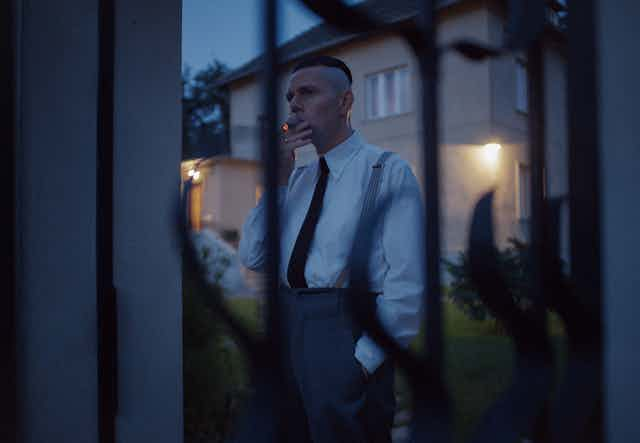Warning: this article contains spoilers.
The Zone of Interest opens by introducing viewers to a husband, wife and their family as they picnic by a river. The scene seems idyllic. Shortly after, the family drives home. Everything seems normal – but on closer inspection, their number plate is adorned with the insignia of the SS, the elite guard of the Nazi regime.
This scene encapsulates why The Zone of Interest is so unsettling. It depicts the everyday life of Auschwitz commandant Rudolf Höss (Christian Friedel), his wife, Hedwig (Sandra Hüller) and their family – yet, industrialised, genocidal violence moves along, continuously, in the background and periphery.
Through meticulous camera setup and editing, writer and director Jonathan Glazer’s film depicts scene after scene of the daily routine of Rudolf, Hedwig and their children. Just as the viewer is becoming immersed in these scenes – perhaps even disturbingly aligning themselves with these characters – the film jarringly cuts away.
It cuts to abstracted, pure, bright red or white frames, to Mica Levi’s gut-wrenching, cacophonous soundtrack, or scenes disruptively shot with night vision cameras.
Creating the Höss home
Production designer, Chris Oddy, and his team built the Höss house and planted the garden from scratch. The set was constructed on location in Poland, directly next to Auschwitz, using detailed, historical records and photographs.
While domestic scenes of Höss and his family are routine, Johnnie Burn’s sound design is abrasive and incessant.

A continuous, low-pitched, industrial humming sound plays throughout. Its source is not shown, but it could be the sound of the crematoria. As the family go about their daily lives, there are distant screams, shouting, dogs barking and gunshots. The Höss family don’t seem to register them, apparently desensitised.
The film is formally rigorous. It makes use of the hidden cameras Glazer previously deployed in docu-fiction, Under the Skin (2013). With director of photography Łukasz Żal, Glazer positioned ten fixed cameras and 20 microphones around the Höss house.
Żal has described how he and Glazer endeavored to use exclusively natural lighting, to avoid aestheticising the unthinkable.
The problem with making films about the Holocaust
The problem with making films about the Holocaust is that formal decisions inevitably also become ethical ones. The choices filmmakers make about camera movements, angles, lighting and editing have as much ethical significance as what is in front of the camera.
Audiences are familiar with (perhaps anaesthetised to) the typical iconography of the Holocaust in film, such as watchtowers, barbed wire and smoke. In her comprehensive study of Holocaust film, Indelible Shadows (1983), historian Annette Insdorf describes these images as a kind of figurative shorthand: “the visual part representing the unimaginable whole”.

In The Zone of Interest, these recognisable images are disturbingly estranged. For example, from the perspective of the garden, a watchtower is visible in the background, partially obscured by pristine white sheets hanging on a washing line.
Instead of showing the operation of the crematoria as a closeup, the pulsating orange-red light from their chimneys illuminates Hedwig’s mother’s bedroom, disturbing her sleep. Children play in a pool in Hedwig’s cherished garden, atop of which is a shower, symbolically associated with the extermination of innocents in the camp.
Representing gas chambers on film
Mainstream cinema relies on narratives of conflict and resolution, and so tends towards a binary notion of “good” and “evil”. The Zone of Interest, however, in Friedel’s disquieting, cold portayal of Höss, shows that genocide is perpetrated not by “evil”, but by administrators – concerned with numbers, timetables and blueprints.
Höss is shown meeting with several men in suits, matter-of-factly explaining detailed plans for more efficient gas chambers immediately after a scene where Hedwig gossips with her friends. Such a contrast underlines that the ordinariness of perpetration.
Critics have praised or condemned films about the Holocaust such as Son of Saul (2015), Schindler’s List (1994) or The Boy in the Striped Pyjamas (2008) for the techniques they use to represent gas chambers. Claude Lanzmann, director of Shoah (1985), once said that if direct footage of the act of genocide in the gas chamber were to exist, he would destroy it. Watching it would transgress the most profound moral taboo.

One of the starkest moments in The Zone of Interest is its representation of the gas chambers. Rudolf Höss is leaving a party for the Nazi leadership in Berlin. He looks at something off screen, down a dark corridor. The film cuts to a close-up of a small, white circle, surrounded by blackness – the spy hole on the door of a gas chamber.
This is followed by a disorienting jump to the present day. Cleaners dust the piles of victims’ suitcases, shoes and other personal belongings in the Auschwitz Memorial Museum.
Glazer was stunned to discover that one of the walls of the Höss family garden directly bordered the extermination camp. He has said that the concept of his film “became about that wall”.
Glazer’s film underscores how walls, borders or geographic distance “compartmentalise”, in producer James Wilson’s words, the suffering of others. Such visual barriers become the mechanism through which genocide has been – and continues to be – enabled.
The Zone of Interest is unsettling because of how it portrays perpetration of the Holocaust as normal, therefore leaving the viewer with the disquieting notion that anyone, in the right conditions, can be responsible for unspeakable things.

Looking for something good? Cut through the noise with a carefully curated selection of the latest releases, live events and exhibitions, straight to your inbox every fortnight, on Fridays. Sign up here.

